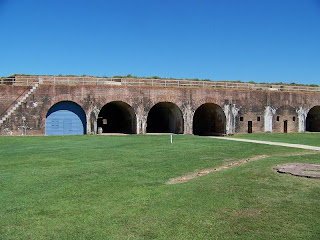The early French settlers of Mobile were quick to learn what other early settlers of the Gulf Coast had already discovered, that wooden forts and defenses quickly deteriorated in the humid conditions and heavy rains.
It is a little known fact that the Mobile Bay area of Alabama usually receives more rain each year than famously rainy places such as Seattle, Washington. It is not uncommon for a summer hurricane or tropical storm to bring 8 to 10 inches of rain in a single event, sometimes more. These heavy tropical rains washed away earthworks and rotted the log stockades erected by the French to defend their toehold on Mobile Bay.
As a result, in 1723, the French started construction of a solid masonry fort on Mobile's waterfront. Built of brick on a foundation of stone, the square bastioned fort was the strongest erected on the Gulf Coast to that point. Armed with numerous cannon, the work was named Fort Conde after the Prince of Conde and was surrounded with a dry moat and additional defensive earthworks.
Fort Conde served as the primary protector of French Mobile until the city was surrendered to England in 1763 at the end of the French and Indian War. The British took over the fort and renamed it Fort Charlotte. It became an important post during the American Revolution and one of Alabama's two little known Revolutionary War battles took place there on May 10-13, 1780, when Allied forces led by the Spanish General Bernardo de Galvez laid siege to the fort.
Fort Charlotte was surrendered to Galvez's overwhelming force and remained in Spanish hands until it was seized by the United States in 1813. The fort was in bad condition then and was not held for much longer. It was dismantled during the 1820s.
Fort Conde's history, however, was far from over. Now partially reconstructed, it serves as a welcome center that greets visitors to Mobile. To learn more, please visit
www.exploresouthernhistory.com/fortconde.






